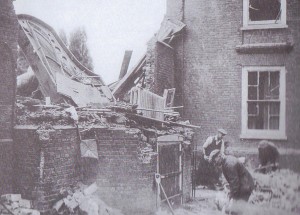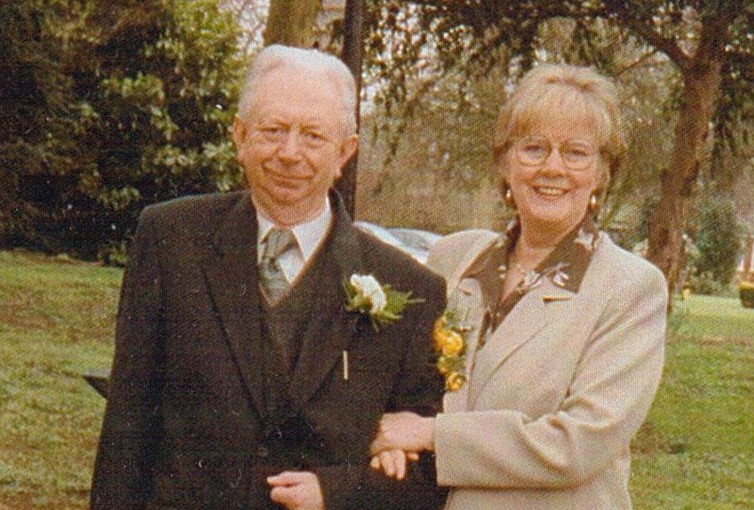By Jim Hollands
When Arthur Woodgate, who at 100 years of age is the magazine’s oldest contributor, mentioned an ‘unknown Rye hero’ in his War & Peace article back in April it was a long shot to expect that after 74 years the identity of the people involved would come to light.
Arthur wrote
“Everybody in Rye knows that Godfrey’s Row was completely destroyed and several people were killed but not many people seem to know of a young teenage boy bent over his younger sister to keep falling rubble from hurting her. He took many bumps and bruises from bricks and plaster that would have hit her. This story went round town at the time but only as a rumour. When both children were brought out alive the rumour died down and not much more was said, the war was moving so fast, there was little time to dwell on individual events. I have often thought about the incident and wonder if any reader can cast new light, and perhaps even put a name to the young lad”.
The Mystery is Solved
Well Arthur, the mystery is solved. A phone call from Jennifer Giles and later another from her brother John, the two children who were trapped ‘under the stairs’ when a German bomb destroyed every house in Godfrey Row, revealed the whole story.
John, who is now eighty-four, was ten years old when a German bomber probably returning after being intercepted and turned back from a raid on RAF Biggin Hill or RAF Kenley, dropped its bomb load over Rye. John remembers his mother talking on the doorstep with Mr. Bumptead who lived next door at number four.
“It was about one pm. Mother must have had some sort of premonition” John recalled. “Mum ushered both my sister Jennifer, who was only three years old at the time, and I under the stairs and returned to her conversation with Mr. Bumpstead. She dashed back seconds later and made a dive for the cupboard to join us. It was at that moment the bomb hit and exploded.”
All John remembers is being buried with his sister.
“I did not shield her with my body because we were both trapped under rubble and could not move. I held her hand and talked to her for what seemed a very long time. Mother was rescued first but I have no recollection of this happening. Next they got to me and pulled me out. I was taken over the road to the Pipemakers Arms and given lemonade to clear the dust out of my mouth. I was transferred into a neighbours house with mum and it was there they brought my sister. I remember Jennifer sticking out her tongue to show how much dust she had on it.”
Mr. G. Bumpstead, Mrs. F. Bumpstead and Mr. J.H. Bumpstead at all died as a result of the bombing. Bill Cutting and family were bombed out and made homeless at number 3 Godfrey Row and Tom Watson at no. 2 and Phil Ockenden at No. 1 also had to find new places to live.
Bombs from the same aircraft exploded at 47 The Mint and the Sinden family lost their house. Another bomb fell on No 2 Mermaid Street and the final bomb in the stick wiped out the famous Garden Room at Lamb House
A few days after the bombings many Rye women and children were evacuated. Many went to Bedford, among them were John and Jennifer Giles and their mother. They made their home in Bedfordshire and never returned to live in Rye. When they left the town they had just the clothes they stood up in, everything in their house had been totally destroyed.
Both John and Jennifer grew up, went to school and later found jobs in the Bedford area. John met May Grover of Rochforth, Essex at Southend on Sea. They were married in 1951 and have spent 63 happy years together. Jennifer also married in the Bedford area.
Jennifer Giles, now Mrs. Jennifer Caves wrote the following words about the bombing of Godfrey Row all those years ago.
“After the bomb fell, killing our neighbours, Mr. & Mrs. Bumpstead and their son, and destroying Godfreys Row, Wish Street, we lost everything but escaped with our lives due to the fact that mum had hidden us in the cupboard under the stairs.
“Soon after we were all evacuated to Bedford as were most of the pupils from Rye Grammar School. We lived in several different lodgings until 1948, when we were given our own home. We settled in Bedford. Dad liked it here! In time John and I had families of our own to look after. After the War and on through the 1950’s we visited Rye for our annual holidays, we still had many aunts, uncles and grandparents to see. They were good times, we also enjoyed hop picking with everyone.
“Rye is still very dear to our hearts but we don’t return as often now. My daughter visits twice a year and always buys a copy of the magazine for John, which was where we read about the ‘unknown hero’ in The War Memories of Arthur Woodgate in the April edition”.
All those years ago their lives were nearly lost, then changed completely when that bomb hit their house.
18 August 1940 was life changing day for them, it was also a day that changed the course of the Battle of Britain. Described as ‘The Hardest Day’ the Luftwaffe changed direction and attacked the RAF Airfields. Both Biggin Hill and Kenley the two main target airfields were home to important Sector operations rooms, from which the British fighters were directed into action.
The RAF pilots out-fought the Luftwaffe and Fighter Command leaders outwitted Hitler and Goering. Two days after John and Jennifer Giles so narrowly escaped the Nazi bomb, Winston Churchill boosted British morale with the unforgettable words “Never in the field of human conflict was so much owed by so many to so few”.

the Garden Room at Lamb House. Benson’s grand piano can be seen amongst
the wreckage.
Picture from Jo Kirkham’s “Rye’s War”
The Garden Room Lamb House
The first bomb in the stick fell on Godfrey Row, the final bomb wiped out the famous Garden Room at Lamb House where Henry James had entertained many eminent figures of the day when he lived at Lamb House. Among them H.G. Wells, A.C. and E.F. Benson, Max Beerbohm. Hilaire Belloc, G.K. Chesterton, Joseph Conrad, Stephen Crane, Ford Maddox Ford, Edmund Gosse, Rudyard Kipling, Hugh Walpole and Edith Wharton.
After James’ death in 1916 the house became the home of brothers, A.C. and E.F. Benson.The view from the bow window of the Garden House was to give E.F. Benson the inspiration for his Mapp and Lucia books.
Edward White Benson became a popular figure in Rye, He was Mayor of Rye From 1934-1937 and lived at Lamb House from 1919-1940. A third TV series based on his Mapp and Lucia novels is in the process of being made in Rye at the present time.
Benson died at University College Hospital, London on 29 February 1940, less than six months before the German bomb destroyed his beloved Garden Room where he had spent so many hours creating the stories of Tilling (Rye) that are still enjoyed by millions today.
From the August 2014 issue of Rye’s Own”
All articles, photographs and drawings on this web site are World Copyright Protected. No reproduction for publication without prior arrangement © World Copyright 2015 Cinque Ports Magazines Rye Ltd., Guinea Hall Lodge Sellindge TN25 6EG
